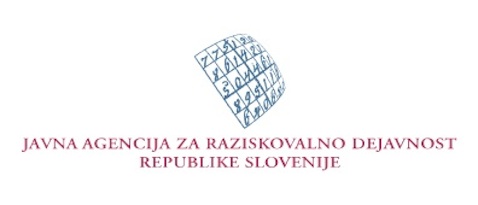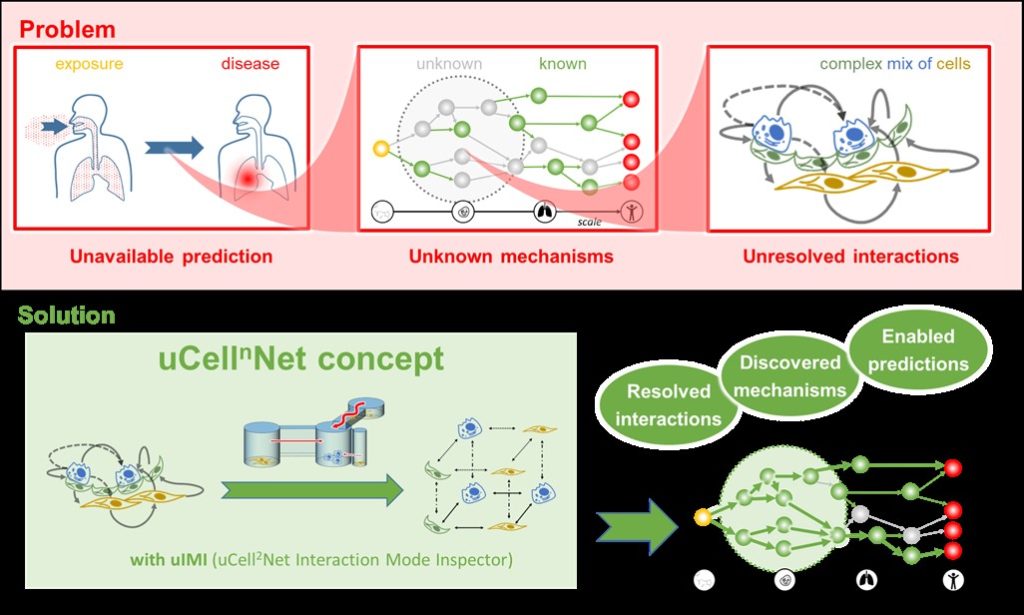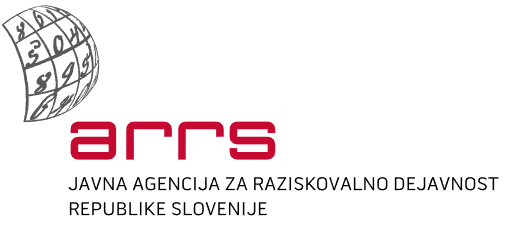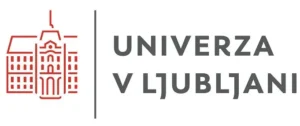Applied and industrial projects
Applied projects
L7-4535 Concept development for mechanistic prediction of fibrosis and initiation of blood coagulation induced by inhaled materials (uCellnNet), October 1, 2022-September 30, 2025
Code: L7-4535
Period: 1. 10.2022-30. 9. 2025

Project name: dr. Tilen Koklič
Research organisations:
Infinite, development of biomedical technologies, LLC
Researchers:
- dr. Janez Štrancar
- dr. Stane Pajk
- dr. Iztok Urbančič
- dr. Rok Podlipec
- dr. Hana Kokot
- dr. Janja Božič
- dr. Boštjan Kokot
Young researcher:
Technicians:
Project description:
Project description:
Background
Every year, 7 million people die due to inhalation of particulate matter in air pollution causing severe chronic-inflammation-related diseases, including pulmonary fibrosis, and blood coagulation disorders. With increasing amounts of man-made nanoparticles introduced to the market and into the environment, inhalation hazard is constantly increasing. To mitigate the risk, efficient nanotoxicological assessment solutions are required.
Problem
Efficient prediction of chronic-inflammation-related diseases is currently hindered by the lack of mechanistic understanding and current toxicological assessment framework. Recently, 200 man-years have been spent in our discovery of a mechanism responsible for triggering chronic inflammation. To understand the development of even more complex diseases in a much shorter time, a paradigm shift in mechanism discovery, in an animal-free fashion, is absolutely necessary.
Aim
The uttermost goal of the proposed project is to develop the paradigm-shifting concept of high-throughput identification of the causally connected network of molecular key events and validate it in the case of nanomaterial-induced fibrosis and initiation of blood coagulation.
Solution
To foster mechanistic discoveries of disease development, we propose a novel uCellnNet concept, by which we aim to disentangle a response of a natively complex tissue with an entangled network of interactions and overwhelming molecular events among multiple cell types into a network of pairs of individual cell types that exhibit different modes of interactions. For high-throughput monitoring of the latter in real-time, the glass-chip cell-populated device with microscale features – uCellnNet Interaction Mode Inspector – will be developed. Finally, we will validate the here proposed uCellnNet concept on a hypothetical pathway of initiation of blood coagulation and the development of fibrosis, involving the three key cell types (pulmonary epithelial cells, macrophages, and fibroblasts).
Team strength
To achieve such an ambitious goal we gathered a multidisciplinary team that has previously already contributed to the discovery of a mechanism of nanoparticle-induced chronic inflammation, published in the prestigious journal Advanced Materials (IF 27). The team consists of top-level experts in advanced high-resolution live-cell imaging, toxicology of inhaled nanomaterials, systems biology, lipid regulation of coagulation enzymes, artificial intelligence guided image analysis, and microscale glass substrate prototyping, thus assuring the project feasibility.
Impact (scientific, social, economic)
If successful, this project will directly impact the understanding of the development of fibrosis. In addition, uCellnNet concept can certainly boost mechanistic research of early molecular events and their causal connections in the development of nanoparticle-induced diseases and chronic diseases in general, which can be implemented in future regulatory frameworks much faster. This can in turn facilitate high-throughput animal-free toxicological assessment and prediction of nanomaterial safety. Thus, this project directly supports the safe introduction of various powders, microscale materials, and nanomaterials into the everyday market, affecting chemical, nanotech, and electronic industry sectors.

Visit lab website here.
Project phases and their realization:
The activities will involve three main work packages (WPs), devoted to achieve
WP1: Development of uCellnNet Interaction Mode Inspector (uIMI) glass-chip device
WP2: Exploring interactions in uCell2Net (chronic inflammation) and uCell3Net (fibrosis)
WP3: Management and dissemination
References:
/
L1-2607 Magnetic, electric and stress – field programming of shape response in polymer-dispersed liquid crystal elastomers – based actuators, September 1, 2020-August 31, 2024
Code: L7-4491
Period: 1. 10. 2022-30. 9. 2025

Project head: prof. dr. Igor Muševič
Research organisation:
| Institut “Jožef Stefan” |
| Onkološki Institut Ljubljana |
| Univerza v Ljubljani, Fakulteta za elektrotehniko |
| Univerza v Ljubljani, Fakulteta za matematiko in fiziko |
Researchers:
L7-7580-2 Advanced electrocaloric energy transformation, March 1, 2016-February 28, 2019
Code: L1-2607
Period: September 1, 2020-August 31, 2024 Provider of funds logo:

Project head:Andraž Rešetič, PhD
Research organisation:
Researchers:
Project description:
The development of soft flexible materials with morphing and shape-programmable abilities is essential for technological progress of soft robotics, biomechanics, and flexible electronics. However, morph-on-demand materials remain a rather elusive class of smart materials. Shape-programmable matter capable of transforming between three-dimensional shapes in response to external stimuli such as light, heat, electric and magnetic fields is a class of active materials whose geometry can be controlled for performing tasks beyond the operational scope of conventional machines or robots.
In this project, we are proposing the development of a method to produce a new generation of 3D-printable soft material with anisotropic response. The material will be based on the recently developed polymer dispersed liquid crystal elastomers (PDLCE). Such composite material consists of thermomechanically active liquid single crystal elastomer (LSCE) microparticles, dispersed and oriented in a crosslinked polymer matrix. The particle orientation can be spatially modulated using an external magnetic alignment field over the composite volume, resulting in custom-tailored, temperature responsive shape changes of the specimen. We have recently devised a method of producing a suspension of anisotropically shaped LSCE microparticles with their liquid crystal ordering and consequently, direction of thermomechanical actuation, aligned along the particle’s longer axis. Anisotropically shaped LSCE particles can thus be oriented using simple laminar flow, present during deposition while 3D printing the material. The use of the state-of-the-art robotic hand with a mounted polymer dispensing unit, will enable us to precisely control the imprinted thermomechanical anisotropy, by exploiting the robotic hand’s six degrees of freedom of movement in order to deposit PDLCE voxels at arbitrary angles. The developed 3D printable ink will be used to print a tube capable of peristaltic movement, triggered by consecutive heating and cooling of the specimen via incorporated heating wires or by UV/
microwave irradiation absorbing nanostructures additionally functionalizing the LSCE composite.
The realization of a 3D printed peristaltic tube will demonstrate the applicative advantages of our printing method and of the PDLCE 3D printable ink, by producing a specimen with complex morphing abilities that cannot be achieved by any of the currently developed additive manufacturing technologies.
Visit lab website here.
Project phases and their realization:
Phase 1
- preparation of polydomain LSCE bulk materials (temperature-controlled crosslinking of the mixture of commercially available chemicals);
- preparation of polydomain LSCE bulk materials with deuterium labelled constituents (for characterization purposes);
- synthesis of MoS2 nanotubes by sulphurization of Mo6S4I6 nanowires at 1073 K in a reactive gas composed of 98 vol% Ar, 1 vol % of H2S and 1vol % of H2 for 1h;
Phase 2
- preparation of PDLCE resin by freeze-fracturing of bulk LCE and frozen matrix material in a cryogenic planetary ball mill;
- preparation of PDLCE printable ink by pre-shearing the PDLCE resin using custom-build rotational parallel plates inside a temperature controlled chamber;
- determination of liquid crystal ordering inside deformed PDLCE microparticles of a PDLCE printable ink via quadrupole-perturbed deuteron NMR spectroscopy;
Phase 3
- determination of LSCE microparticles orientational order and its associated order parameter Q in PDLCEs via quadrupole-perturbed deuteron NMR spectroscopy;
- determination of bulk LSCE, matrix elastomer, and PDLCE thermomechanical coefficient λ in a temperature-controlled extensometer;
Phase 4
- preparation of PDLCE composite material and peristaltic tube by fused layer deposition of flow-oriented PDLCE printable ink, deposited by a robotic arm with a mounted polymer dispense unit;
Phase 5
- characterization of peristaltic tube performance by analysis of the flow velocity, pressure and volume of expelled liquids using flow and pressure sensors;
- physical modelling of the PDLCE peristaltic tube performance based on mechanical and thermomechanical properties of the PDLCE material, imprinted spatial alignment of PDLCE microparticles and tube’s geometrical constraints.
References:
/
Past projects
L7-7580-2 Advanced electrocaloric energy transformation, March 1, 2016-February 28, 2019
Leader: Professor Zdravko Kutnjak, PhD
Research programme: Magnetic resonance and dielectric spectroscopy
Code: L7-7580-2
Duration: March 1, 2016–February 28, 2019
L4-7547 Behavior of wood and lignocellulosic composites in external conditions, March 1, 2016-February 28, 2019
L7-7561 Microscopic characterisation and optimisation of laser impulse effect on the retina, March 1, 2016–February 28, 2019
Leader: Associate Professor Janez Štrancar, PhD
Research programme: Experimental biophysics of complex systems
Code: L7-7561
Duration: March 1, 2016–February 28, 2019
L2-6768-2 Micro-electromechanical and electrocaloric layer elements, July 1, 2014-June 30, 2017
Leader: Professor Zdravko Kutnjak, PhD
Research programme: Magnetic resonance and dielectric spectroscopy
Code: L2-6768-2
Duration: July 1, 2014–June 30, 2017
L4-5517 Prevention of moisture in wood as a measure of effectiveness of protection of wood against fungal decay, August 1, 2013-July 31, 2016
Leader: Professor Igor Serša, PhD
Research programme: Experimental biophysics of complex systems
Code: L4-5517
Duration: August 1, 2013–July 31, 2016
L1-8135 Biopharmaceuticals: sensor for aggregation of protein particles based on liquid crystals, May 1, 2017-April 30, 2020
Code: L2-8180-2
Project name: Domain engineered ferroelectric ceramic layer elements for efficient energy harvesting and energy conversion applications
Period: 1.5.2017 – 30.4.2020 Provider of funds logo:

Project head: Malič Barbara, PhD
Project head within the F5 Department: Zdravko Kutnjak, PhD
Research organisation:
L2-9254 Space and time forming of laser light for minimaly invasive ophtamologic treatments, July 1, 2018-June 30, 2021
Code: L2-9254
Project name: Prostorsko in časovno oblikovanje laserske svetlobe za minimalno invazivne oftalmološke posege (Slovene)
Period: 1.7.2018 – 30.6.2021 Provider of funds logo:

Project head: Tomaž Požar, PhD
Project head within the F5 Department: Janez Štrancar, PhD
Research organisation:
Industrial Projects
PR-03395 MRI recording of samples, April 1, 2020-March 31, 2017
Leader: Professor Igor Serša, PhD
Research programme: Experimental biophysics of complex systems
Financed by: Krka, tovarna zdravil, d.d.
Code: PR-03395
Duration: April 1, 2010–March 31, 2017
PR-05151 AFM research of liquid crystals, November 1, 2012-January 31, 2016
Leader: Associate Professor Miha Škarabot, PhD
Research group: Physics of soft matter, surfaces and nanostructures
Financed by: Merck Kgaa
Code: PR-05151
Duration: November 1, 2012–January 31, 2016
PR-06502 Analyses using nuclear quadrupolar resonance (NQR) method, April 28, 2015-April 30, 2016
Leader: Assistant Professor Tomaž Apih, PhD
Research programme: Magnetic resonance and dielectric spectroscopy
Financed by: Lek, d.d.
Code: PR-06502
Duration: April 28, 2015–April 30, 2016
PR-07072 Development of protective filters for welders, January 1-December 31, 2016
Leader: Professor Igor Muševič, PhD
Programska skupina: Physics of soft matter, surfaces and nanostructuresr
Financed by: Kimberly-Clark
Code: PR-07072
Duration: January 1, 2016–December 31, 2016
PR-07110 System for manipulation of melt flow, February 17-March 31, 2016
Leader: Professor Denis Arčon, PhD
Research programme: Magnetic resonance and dielectric spectroscopy
Financed by: Izoteh, d.o.o.
Code: PR-07110
Duration: February 17, 2016–March 31, 2016
PR-07199 Microscopic characterisation and optimisation of laser impulse effect on the retina, March 1, 2016-December 31, 2018
Leader: Associate Professor Janez Štrancar, PhD
Research programme: Experimental biophysics of complex systems
Financed by: Optotek, d.o.o.
Code: PR-07199
Duration: March 1, 2016–December 31, 2018
PR-08945 Detection of Non-Anthropogenic Air Pollution Project (DNAAP), July 1, 2018-June 30, 2020
Code: PR-08945
Duration: 1. 7. 2018 –30. 6. 2020
Head of the project: dr. Griša Močnik
Financed by: AEROSOL d.o.o.
PR-08672 Airplane measurements, April 10-December 31, 2018
Code: PR-08672
Duration: 10. 4. 2018–31. 12. 2018
Head of the project: dr. Griša Močnik
Financed by: AEROVIZIJA d.o.o.
PR-08508 IMALA – Instrument for measuring absorption of light in aerosols, January 1, 2018-November 30, 2020
Code: PR-08508
Duration: 1. 1. 2018–30. 11. 2020
Head of the project: dr. Igor Muševič
Financed by: AMES d.o.o.
PR-08099-2 Irradiation and Analysis of Nano SIC Samples in the Year 2017, June 20, 2017-June 30, 2018
Code: PR-08099-2
Duration: 20. 6. 2017–30. 6. 2018
Head of the project: dr. Vid Bobnar
Financed by: National Nuclear Research Center
